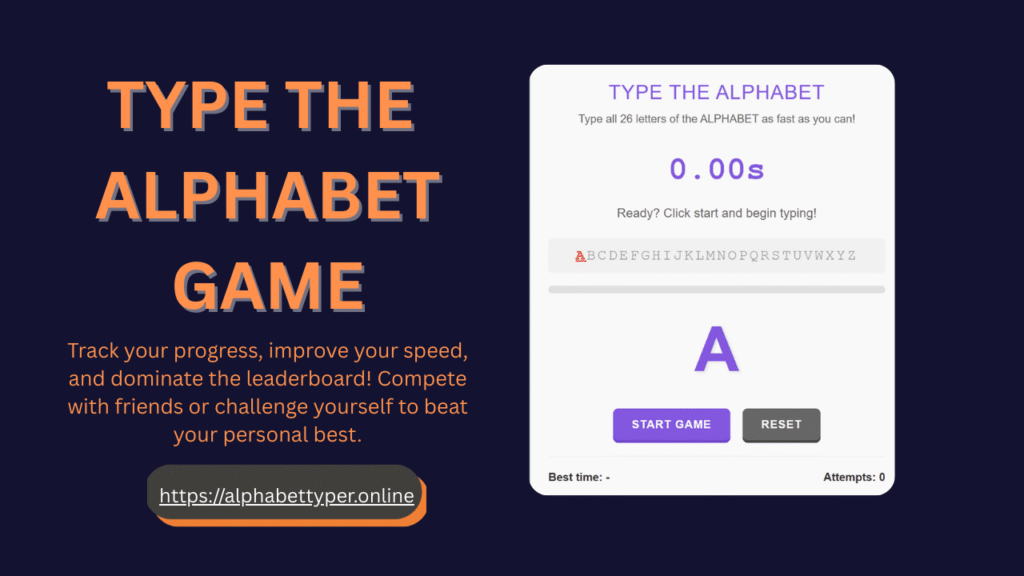Did you know that the average person can type the alphabet in about 10 seconds, but experts can do it in under 3 seconds? Typing the alphabet fast is more than just a cool party trick—it’s a skill that can boost your overall typing speed, make you better at gaming, and even help you ace typing tests. Whether you’re a student, gamer, or just want to impress your friends, learning to “Type the Alphabet” quickly is a fun and useful challenge.
In this guide, you’ll learn simple steps to type the alphabet faster, from understanding the basics to mastering advanced techniques. We’ll cover proper hand positioning, practice methods, and common mistakes to avoid. Plus, we’ll show you how tools like Type the Alphabet can make your practice fun and effective. Ready to become an alphabet typing pro? Let’s get started!
Understanding the Basics of Alphabet Typing
Typing the alphabet fast means typing all 26 letters (A to Z) in order as quickly as possible without mistakes. It’s a popular challenge because it’s simple but tests your keyboard skills. On average, beginners take 10–15 seconds to type the alphabet, while experts can do it in 2–5 seconds. Your goal? Beat your personal best and aim for speed and accuracy.
Why is this skill important? Typing the alphabet helps you get comfortable with the keyboard. It builds muscle memory, which is when your fingers automatically know where to go without thinking. This makes you faster at typing words, sentences, or even gaming commands. By practicing with game tool you can make learning the alphabet sequence fun and track your progress easily. It’s the perfect starting point for anyone wanting to improve their typing skills.
Essential Prerequisites
Before you start typing the alphabet at lightning speed, you need a strong foundation. Here’s what you should focus on:
- Proper Posture: Sit up straight with your feet flat on the floor. Keep your elbows at a 90-degree angle and your wrists relaxed. Good posture prevents strain and helps you type faster.
- Keyboard Familiarity: Know the QWERTY keyboard layout. If you’re new, spend a few minutes looking at the keys to understand where each letter is.
- Home Row Finger Placement: Place your left fingers on A, S, D, F and your right fingers on J, K, L, ; (the “home row”). Your thumbs rest on the spacebar. This is your starting position for typing.
- Look at the Screen: Avoid looking at the keyboard. Focus on the screen to train your fingers to find keys by feel. This is called touch typing and is key to speed.
These basics set you up for success. Practice them daily, and you’ll be ready to tackle the alphabet challenge.
Core Techniques to Type the Alphabet Faster
To type the alphabet fast, you need the right techniques. Here are three key areas to focus on:
A. Finger Assignment Strategy
Each finger has specific letters it should type on a QWERTY keyboard. Here’s a simple breakdown for the alphabet:
- Left Hand:
- Pinky: A, Q, Z
- Ring finger: S, W
- Middle finger: D, E
- Index finger: F, R, T, G, C, V, B
- Right Hand:
- Index finger: H, Y, U, N, M, I
- Middle finger: I, O
- Ring finger: K
- Pinky: L, P
Break the alphabet into “finger zones”:
- Left pinky zone: A, Q, Z
- Left index zone: F, R, T, G, C, V, B
- Right index zone: H, Y, U, N, M
- Right middle zone: I, O
Practice typing letters in each zone to get comfortable with finger assignments. This reduces confusion and speeds up your typing.
B. Movement Patterns and Flow
Typing the alphabet fast is like a dance for your fingers. You want smooth transitions between letters. Some combinations, like G to H or Q to R, are tricky because they involve switching hands or reaching far. Practice these pairs slowly at first, then speed up.
Focus on rhythm. Try typing to a steady beat, like a song. For example, say “A, B, C” out loud in a rhythm to keep your fingers moving consistently. Avoid pausing between letters—think of it as one fluid motion from A to Z.
C. Mental Preparation
Your brain plays a big role in typing speed. Visualize the keyboard in your mind so you know where each letter is without looking. Practice saying the alphabet in your head to memorize the sequence perfectly. For example, before typing, think “A, B, C, D…” to prepare your fingers.
Another trick is anticipating the next letter. As you type “B,” your brain should already be thinking “C.” This mental prep reduces hesitation and keeps you moving fast.
Step-by-Step Practice Method
To type the alphabet fast, follow this three-phase practice plan. It’s designed to build your skills step by step.
Phase 1: Slow and Accurate (Week 1–2)
Focus on accuracy first. Speed comes later. Here’s how:
- Break the alphabet into chunks: A–F, G–L, M–R, S–Z.
- Practice each chunk slowly, using the correct fingers. For example, type A–F (A, B, C, D, E, F) 10 times without mistakes.
- Spend 10–15 minutes daily practicing. Use alphabettyper.online to type these chunks and get instant feedback.
- Goal: Type each chunk perfectly before moving to the next.
Phase 2: Building Speed (Week 3–4)
Now, start speeding up while keeping accuracy. Here’s the plan:
- Combine chunks into longer sequences, like A–L or M–Z. Then, try the full alphabet (A–Z).
- Time yourself using a stopwatch or alphabettyper.online. Aim to beat your previous time by a second or two.
- Practice 15–20 minutes daily. Do 5–10 full alphabet runs per session.
- Track your times in a notebook or app to see improvement.
Phase 3: Mastery and Consistency (Week 5+)
This phase is about getting fast and staying fast:
- Aim for consistent times under 10 seconds for the full alphabet.
- Try advanced challenges, like typing the alphabet backward (Z to A) order.
- Practice 10–15 minutes daily to maintain your skills.
With this plan, you’ll go from beginner to pro in just a few weeks!
My Personal Success Story: From Bronze to Gold Medal
Let me share my own journey with alphabettyper.online, which perfectly demonstrates the power of consistent practice. When I first discovered the website, I was excited to test my alphabet typing speed. On my very first attempt, I managed to earn a bronze medal – not bad for a beginner, but I knew I could do much better.

Instead of being satisfied with my initial result, I committed myself to regular practice sessions using the platform’s structured exercises. Day after day, I worked on improving my finger placement, rhythm, and speed. Through continuous daily practice and determination, I gradually saw my times improving, and eventually progressed to silver medal status. The improvement in my typing speed and accuracy was noticeable and encouraging.

But I didn’t stop there. With sustained effort and the systematic approach offered by alphabettyper.online, I kept pushing my limits. Finally, after weeks of dedicated practice, I achieved the coveted gold medal by typing the complete alphabet in just 5.42 seconds! It was an incredible feeling to see such dramatic improvement from where I started.

Currently, I’m working toward my ultimate goal of setting a world record through alphabettyper.online. My journey from beginner to expert has shown me that with the right tools and consistent practice, extraordinary results are absolutely achievable. I hope my story inspires you to start your own alphabet typing journey!
Common Mistakes and How to Avoid Them
Even with practice, mistakes can slow you down. Here are common ones and how to fix them:
- Rushing Before Accuracy: Typing fast but making errors wastes time.
Solution: Slow down and focus on getting every letter right before speeding up. - Poor Finger Positioning: Using the wrong fingers causes delays.
Solution: Stick to the finger assignments listed earlier and practice them daily. - Skipping Difficult Transitions: Avoiding tricky pairs like Q–R or B–N makes them harder later.
Solution: Practice these pairs separately until they feel natural. - Inconsistent Practice: Skipping days breaks your progress.
Solution: Set a daily practice time, even if it’s just 10 minutes. - Looking at the Keyboard: This slows you down and prevents touch typing.
Solution: Force yourself to look at the screen. Cover your keyboard with a cloth if needed!
Avoiding these mistakes will help you type the alphabet faster and with fewer errors.
Advanced Tips and Tricks
Once you’re comfortable with the basics, try these advanced techniques to shave seconds off your time:
- Breathing Techniques: Stay relaxed by taking slow, deep breaths while typing. Tension in your hands slows you down.
- Metronome Training: Use a metronome app set to 60–80 beats per minute. Type one letter per beat to build a steady rhythm.
- Competition Mindset: Treat practice like a game. Set a goal to beat your best time or challenge a friend. This keeps you motivated.
These tricks take your skills to the next level and make practice more fun.
Tools and Resources for Practice
The right tools can make learning to type the alphabet fast easier and more enjoyable. Here’s what to use:
- Dedicated Typing Tools: Websites like alphabettyper.online are perfect for practicing the alphabet challenge. They offer timed exercises, instant feedback, and fun games to keep you engaged.
- Complementary Exercises: Try other typing games to improve overall keyboard skills.
- Setting Up Practice Sessions: Create a distraction-free environment. Sit at a comfortable desk, use a reliable keyboard, and practice for 10–20 minutes daily. These tools make practice effective and help you see results faster.
Measuring Your Progress
Tracking your progress keeps you motivated. Here’s how to do it:
- Time Yourself Accurately: Use a stopwatch to time how long it takes to type A–Z without errors.
- Set Realistic Goals: If you start at 15 seconds, aim for 12 seconds after a week, then 10 seconds the next. Experts aim for under 5 seconds.
- Track Improvement: Write down your times daily in a notebook or app. Look for patterns, like faster times after consistent practice.
- Increase Difficulty: Once you hit 8–10 seconds consistently, try variations like typing backward to keep improving.
Seeing your times drop will motivate you to keep going!
Conclusion
Typing the alphabet fast is a fun and rewarding skill that boosts your overall typing ability. By focusing on proper finger placement, practicing regularly, and avoiding common mistakes, you can go from beginner to expert in just a few weeks. Use the step-by-step plan, advanced tips, and tools like Type the Alphabet Game to make practice easy and enjoyable.
As demonstrated by our featured success story, consistent practice can lead to remarkable achievements – from earning your first bronze medal to reaching gold medal status and potentially setting world records. The journey requires dedication, but the results speak for themselves.
Start today, and you’ll be amazed at how fast you can type the alphabet! Visit our website Type the Alphabet Game to begin your journey and track your progress. How fast can you type A–Z? Try it now and share your best time in the comments!


